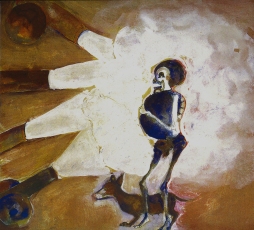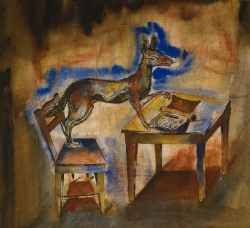 ¡Buenos días! Today we will continue our Indigenous Peoples book reviews with Topilitzkuintli/El perro topil. The story is written in Spanish by Elisa Ramírez Castañeda, translated to Nahuatl by Miguel Ángel Tepole, and illustrated by Francisco Toledo. Toledo is a significant Zapotec artist and activist from the Tehuantepec peninsula, and Ramírez Castañeda is a poet, sociologist and translator who works to spread the importance of indigenous cultures in both Native and non-Native communities. She is also author of the book titled La educación indígena en México,
¡Buenos días! Today we will continue our Indigenous Peoples book reviews with Topilitzkuintli/El perro topil. The story is written in Spanish by Elisa Ramírez Castañeda, translated to Nahuatl by Miguel Ángel Tepole, and illustrated by Francisco Toledo. Toledo is a significant Zapotec artist and activist from the Tehuantepec peninsula, and Ramírez Castañeda is a poet, sociologist and translator who works to spread the importance of indigenous cultures in both Native and non-Native communities. She is also author of the book titled La educación indígena en México,  where she writes extensively about indigenous peoples of Mexico and their inclusion/exclusion in the Mexican nation and education. Toledo and Castañeda are also married with two children.
where she writes extensively about indigenous peoples of Mexico and their inclusion/exclusion in the Mexican nation and education. Toledo and Castañeda are also married with two children.
This Nahuatl story tells the tale of why dogs always smell each others’ rear-ends when they first meet one another. Kids will find this story silly and entertaining. In the story, dogs have been continually mistreated by humans. To resolve this, they decide to bring a message to the region’s leader, Señor Tlalocan, so that he will punish the humans. They choose one dog that would deliver the message, and name this dog the Perro Topil. Since the Perro Topil will be crossing rivers and mountains, the dogs carefully consider a safe place to keep the message during his journey. In the end, they decid to put it in the Perro Topil’s rear-end. Time goes by, and the message never reaches Señor Tlalocan.  We are to surmise that this explains why, even today, when dogs first meet, they smell each others’ rears in search of the Perro Topil and the message he carries.
We are to surmise that this explains why, even today, when dogs first meet, they smell each others’ rears in search of the Perro Topil and the message he carries.
I am happy to see the inclusion of Nahuatl in the text, especially since the story itself is from the Nahuatl people. If you are interested in the Nahuatl language and culture, you can check out a post I wrote a few weeks ago about The Princess and the Warrior by Duncan Tonatiuh. This post contains various links about the Nahuatl language, along with other indigenous languages in Mexico.
The paintings in this book are exquisite and exemplary of Francisco Toledo’s painting style. Each turn of the page reveals a new painting extending across two pages. These illustrations provide an opportunity to discuss the Mexican muralist movement, which greatly influenced Francisco Toledo’s work. For those unfamiliar with Mexican muralism, the Art History Teaching Resources (AHTR) website provides useful background information and lesson plans.  PBS also has a lesson plan, “The Storm That Swept Mexico | Lesson Plan: Revolutionary Art,” that accompanies a video about the Mexican Revolution; however, the materials can stand alone in regards to their discussion of Mexican muralism. Apart from these lesson plans, students might also benefit from having the chance to discuss the similarities/differences between Toledo and other Mexican muralists.
PBS also has a lesson plan, “The Storm That Swept Mexico | Lesson Plan: Revolutionary Art,” that accompanies a video about the Mexican Revolution; however, the materials can stand alone in regards to their discussion of Mexican muralism. Apart from these lesson plans, students might also benefit from having the chance to discuss the similarities/differences between Toledo and other Mexican muralists.
Saludos,
Kalyn
